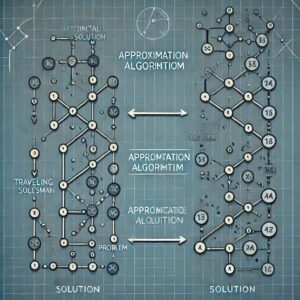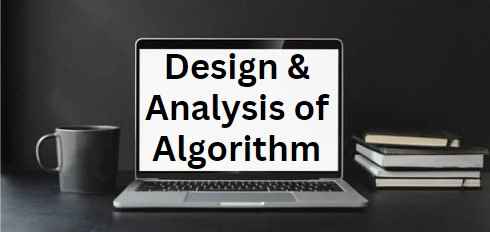Introduction
.
An approximation algorithm is used to find near-optimal solutions for optimization problems, especially when finding the exact solution is difficult or takes too much time (NP-hard problems). These algorithms provide a solution that is close to the best possible answer but in a much shorter time than exact algorithms.

.
How Approximation Algorithms Work
Approximation algorithms aim to find solutions that are close to the optimal solution for complex optimization problems. These problems are often NP-hard, meaning that finding an exact solution would take an impractically long time as the problem size grows. Instead of solving the problem exactly, approximation algorithms provide solutions that are “good enough” within a guaranteed margin of error, called the approximation ratio.
.
Here is how approximation algorithms work in a simple, step-by-step manner –
1. Problem Simplification
Approximation algorithms start by simplifying the problem. Instead of trying to solve the entire problem optimally, the algorithm looks for a quicker way to approximate the solution. This can involve ignoring some parts of the problem or reducing its complexity.
.
2. Greedy Heuristics or Randomized Approaches
Most approximation algorithms use greedy heuristics or randomized approaches.
- A greedy heuristic makes locally optimal choices at each step, hoping that these choices will lead to a globally good solution. For example, in a knapsack problem, a greedy approach might choose the item with the highest value-to-weight ratio first.
- Randomized algorithms make decisions based on random choices and often provide good solutions on average, although they might not always be optimal.
3. Solution Construction
The algorithm constructs a solution by iteratively making decisions that aim to minimize (or maximize) the problem’s objective. At each step, the algorithm evaluates which action would bring it closer to a near-optimal solution.
For example,
- In the Traveling Salesman Problem (TSP), the Christofides Algorithm is a more sophisticated approximation algorithm that guarantees a better approximation ratio. It provides a solution that is at most 5 times the optimal solution for TSP when the problem satisfies the triangle inequality (the direct route between two cities is always shorter or equal to taking a detour).
- The Vertex Cover problem is an NP-hard problem in which the goal is to find the smallest set of vertices that “cover” all the edges in a graph. In other words, for every edge in the graph, at least one of its endpoints must be in the set. An approximation algorithm provides a solution close to the minimum vertex cover in polynomial time, rather than the exact solution, which is hard to compute for large graphs.
.
Approximation Ratio
The approximation ratio is a key concept in approximation algorithms, used to measure how close the solution produced by an approximation algorithm is to the optimal solution of an optimization problem.
.
Definition
The approximation ratio is defined as the ratio between the value of the solution given by the approximation algorithm and the value of the optimal solution. It is expressed as
For minimization problems (like TSP)
- Ratio ≥ 1, meaning the approximation algorithm’s solution is never smaller than the optimal solution.
For maximization problems
- Ratio ≤ 1, meaning the approximation algorithm’s solution is never larger than the optimal solution.
.
Approximation Ratio in TSP (Christofides’ algorithm) is 3/2, meaning that the length of the tour it produces is at most 1.5 times the length of the optimal tour. While the optimal solution is difficult to compute, Christofides’ algorithm gives a solution within 50% of the optimal tour in polynomial time.
The approximation ratio of Vertex Cover Problem is 2, meaning the size of the vertex cover found by the algorithm will be at most twice the size of the optimal vertex cover. In other words, the solution is guaranteed to be within a factor of 2 of the optimal solution.
.
Algorithm
The basic structure of an approximation algorithm can be outlined as
- Input: Optimization problem.
- Step 1: Initialize some starting point or solution.
- Step 2: Apply a heuristic rule or a simplified version of the problem to get a near-optimal solution.
- Step 3: Calculate the cost of this solution.
- Step 4: Evaluate the approximation ratio to check how close the solution is to the optimal one.
- Output: Near-optimal solution.
.
Time Complexity
The time complexity of approximation algorithms depends on the specific problem and the approach used. In general, approximation algorithms are designed to run faster than exact algorithms.
For example, if an exact solution takes exponential time, an approximation algorithm might run in polynomial time.
.
Space Complexity
The space complexity depends on the storage required for the input and the data structures used. Approximation algorithms typically use less space compared to exact algorithms because they do not need to explore all possible solutions.
.
Advantages
- Approximation algorithms provide solutions in a much shorter time than exact algorithms, which is helpful for large problems.
- These algorithms can handle large datasets that exact algorithms cannot process within a reasonable time.
- The solutions are often good enough for practical purposes, even if they are not the absolute best.
.
Disadvantages
- Approximation algorithms do not always provide the best possible solution.
- The quality of the solution can vary, and in some cases, the solution may be far from optimal.
- Each problem requires a unique approximation algorithm, so one algorithm may not work for all problems.
Test Yourself
Q1- Why are approximation algorithms used for NP-hard problems instead of exact algorithms?
Approximation algorithms are used for NP-hard problems because finding an exact solution requires exponential time, which is impractical for large inputs.
Approximation algorithms provide near-optimal solutions in a much shorter time, making them suitable for large-scale problems.
Q2- Explain the significance of the approximation ratio in an approximation algorithm.
The approximation ratio indicates how close the solution produced by the approximation algorithm is to the optimal solution.
For a minimization problem, it shows the ratio of the approximate solution to the optimal solution and is always greater than or equal to 1.
Q3- What is the trade-off between time complexity and solution quality in approximation algorithms?
The trade-off is that while approximation algorithms reduce the time complexity compared to exact algorithms, the quality of the solution may decrease. However, the algorithm guarantees that the solution is within a specified approximation ratio of the optimal solution.
Q4- How does a greedy approach work in an approximation algorithm?
A greedy approach in an approximation algorithm makes locally optimal choices at each step, assuming these local solutions will lead to a near-optimal global solution. It is fast but does not always guarantee the best solution.
Q5- Explain the role of problem simplification in approximation algorithms.
Problem simplification helps reduce the complexity of NP-hard problems by either ignoring less significant aspects or reducing the problem size, allowing the algorithm to provide a good approximate solution in a reasonable time.
Q6- Describe the Christofides Algorithm and its approximation ratio for the Traveling Salesman Problem (TSP).
The Christofides Algorithm is an approximation algorithm for the TSP that guarantees a solution within 1.5 times the optimal solution when the TSP satisfies the triangle inequality. It constructs a minimum spanning tree, then combines it with a matching to create an Eulerian circuit.
Q7- What is the relationship between NP-hard problems and approximation algorithms?
NP-hard problems are difficult to solve exactly due to their exponential time complexity. Approximation algorithms provide efficient ways to find solutions that are close to the optimal solution within a reasonable time frame.
Q8- How does the Vertex Cover approximation algorithm guarantee its solution is within a factor of 2 of the optimal solution?
The 2-approximation algorithm for Vertex Cover selects both endpoints of an uncovered edge, covering all edges efficiently. This guarantees that the solution will be at most twice the size of the optimal vertex cover.
Q9- What type of algorithm makes decisions based on local optimal choices?
Greedy Algorithm
Dynamic Programming
Backtracking
Branch and Bound
Ans – (1)
Explanation – Greedy algorithms make locally optimal choices at each step, hoping to find a globally optimal solution.
Q10- In an approximation algorithm, if the solution’s cost is 120 and the optimal solution’s cost is 100, what is the approximation ratio?
0.83
1.2
1.5
2
Ans – (2)
Explanation – The approximation ratio is calculated as = 120/100 =1.2
Q11- Which method is commonly used to simplify complex problems in approximation algorithms?
Backtracking
Problem Reduction
Divide and Conquer
Dynamic Programming
Ans – (2)
Explanation – Problem reduction simplifies the complexity of NP-hard problems, making it easier to approximate a solution.






